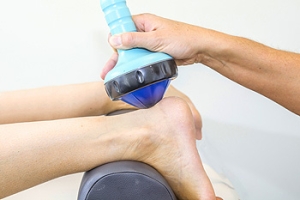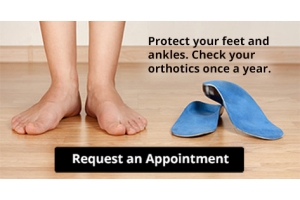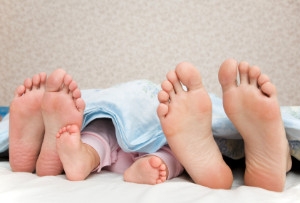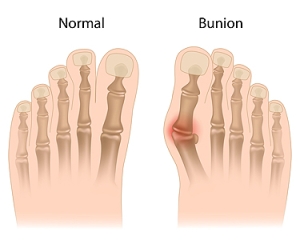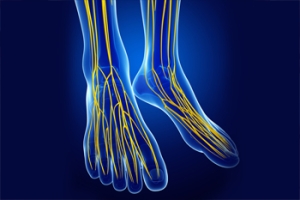BLOG

What’s the Difference Between Corns and Calluses?
 Corns and calluses are both hardened layers of dead skin that can develop on the feet to protect them from stress, irritation and rubbing that has occurred over a period of time—usually as a result of wearing ill-fitting shoes or friction between the toes. The difference between corns and calluses is where they are located: calluses are on the bottom of the toes, and corns are on a bony area on the top of the foot. Corns also have a thick “core” of skin at their base and are either hard (on the top of the toes), or soft (between the toes). Corns, like calluses, can be painful and cause difficulty walking. Occasionally, a little blood may collect where the skin of the foot and the corn meet and cause discoloration or even split the skin and allow an infection to possibly occur. You can help avoid getting a corn by wearing properly sized shoes with plenty of room for the toes to move. If the corn does not go away on its own over several months, or is causing pain or difficulty walking, a podiatrist may relieve discomfort or even remove pressure and pain from the area by safely shaving away some of the dead skin. They may also be able to correct any structural issue you might have using orthotics to distribute weight more evenly.
Corns and calluses are both hardened layers of dead skin that can develop on the feet to protect them from stress, irritation and rubbing that has occurred over a period of time—usually as a result of wearing ill-fitting shoes or friction between the toes. The difference between corns and calluses is where they are located: calluses are on the bottom of the toes, and corns are on a bony area on the top of the foot. Corns also have a thick “core” of skin at their base and are either hard (on the top of the toes), or soft (between the toes). Corns, like calluses, can be painful and cause difficulty walking. Occasionally, a little blood may collect where the skin of the foot and the corn meet and cause discoloration or even split the skin and allow an infection to possibly occur. You can help avoid getting a corn by wearing properly sized shoes with plenty of room for the toes to move. If the corn does not go away on its own over several months, or is causing pain or difficulty walking, a podiatrist may relieve discomfort or even remove pressure and pain from the area by safely shaving away some of the dead skin. They may also be able to correct any structural issue you might have using orthotics to distribute weight more evenly.
Corns can make walking very painful and should be treated immediately. If you have questions regarding your feet and ankles, contact one of our podiatrists of Livingston Foot Care Specialists. Our doctors will treat your foot and ankle needs.
Corns: What Are They? And How Do You Get Rid of Them?
Corns are thickened areas on the skin that can become painful. They are caused by excessive pressure and friction on the skin. Corns press into the deeper layers of the skin and are usually round in shape.
Ways to Prevent Corns
There are many ways to get rid of painful corns such as:
- Wearing properly fitting shoes that have been measured by a professional
- Wearing shoes that are not sharply pointed or have high heels
- Wearing only shoes that offer support
Treating Corns
Although most corns slowly disappear when the friction or pressure stops, this isn’t always the case. Consult with your podiatrist to determine the best treatment option for your case of corns.
If you have any questions please feel free to contact our office located in North Bellmore, NY . We offer the newest diagnostic and treatment technologies for all your foot and ankle needs.
Everything You Need to Know About Corns
Corns are hard and thick areas of skin that form as a result of constant rubbing, friction, or pressure on the skin. They are patches of dead skin with a small plug toward the center. They may appear on the tops and sides of toes and can make walking painful.
Soft corns are typically thinner with a white color and rubbery texture. Soft corns tend to appear between the toes. Seed corns are another type of corn that appear in clusters and can be tender if they are on a weight-bearing part of the foot. Seed corns usually appear on the bottom of the foot and are likely caused by a blockage in sweat ducts.
While corns and calluses are somewhat similar, calluses are a bit different. Calluses are a patch of dead skin that can occur anywhere on the body. In comparison to corns, calluses are usually a bit larger in size. However, both corns and calluses are caused by increased friction on the skin.
There are some risk factors that may increase your chances of developing corns and calluses. If you have bunions, hammertoe, or a bone spur, you are more likely to develop a corn or callus on your foot.
While Corns and Calluses tend to disappear when the friction to the affected area ceases, the help of a podiatrist may be useful in the removal process. It is important to remove the dead skin around the area and this may be done in a few different ways. Moisturizing creams may be helpful in softening and removing the dead skin around the callus. You should never use razors or other pedicure equipment to remove your corns. Doing this may worsen your corn or callus and cause infection.
In some cases, corns and calluses may be caused by abnormal foot structure or walking motion. In such a case, you should seek a podiatrist’s assistance in order to correct the issue.
When Is Shockwave Therapy Used to Treat Plantar Fasciitis?
The plantar fascia is the thick layer of tissue connecting your heel bone to the toes. This area can become inflamed or tear, causing plantar fasciitis. This painful disorder is sometimes experienced as hot, intense pain in your heel, and it may also cause swelling. Pain can be acute in the morning and sometimes may lessen during an activity once you are warmed up. If you are experiencing inflammation only, your podiatrist may try to treat the area with a variety of therapies including orthotics, taping and strapping, steroid injections and other techniques. If your plantar fascia has torn, this is more serious, and your podiatrist may suggest shockwave therapy—which can be successful in repairing damaged connective tissue and relieving pain without resorting to surgery.
Shockwave therapy is a treatment commonly used to treat various injuries and conditions, particularly plantar fasciitis in the feet. To learn more, consult with one of our podiatrists from Livingston Foot Care Specialists. Our doctors can provide the care you need to keep you pain-free and on your feet.
Shockwave Therapy
Shockwave therapy is a new treatment option designed to treat bone conditions such as tennis elbow, shoulder pain, and others. Shockwave therapy uses high intensity sound waves that are directed to the affected tissues of the body with pinpoint accuracy. The effects are very beneficial, leading to a production of collagen fibers, eliminating inflammation.
Who Benefits from Shockwave?
Shockwave is recommended for patients suffering from heel pain and associated problems. Heel pain is a common condition which can be caused by obesity, overexertion, and spending a substantial amount of time on hard floors with your feet exposed and unsupported.
Fast and Easy
The therapy is actually a simple process that can leave patients feeling better the very next day. Shockwave therapy is not as dramatic as it sounds. It enables more blood flow to effected areas, addressing the source of the problem and allowing treatment to last for a long time.
Treatment & Recovery Time
Shockwave treatment will enable your feet to recover quickly. This is especially important since surgery is not required. It is cost effective and does not require the use of anesthesia. This treatment is a better option to surgery, since it is proven safe.
If you have any questions, please feel free to contact our office located in North Bellmore, NY . We offer the newest diagnostic and treatment technologies for all your foot and ankle needs.
Treating Heel Pain with Shockwave Therapy
Shockwave therapy is one treatment option for plantar fasciitis, a condition that causes heel and foot inflammation and pain. This type of injury is often caused by overworking the feet. Heel pain is most common in people that exercise often, individuals who are overweight, and people whose profession require them to stand for long periods of time.
Heel pain can be caused by a number of problems including ill-fitting shoes, strenuous exercise routines or work hazards. Simple treatment options involve buying new shoes, taking ibuprofen, doing heel and foot exercises, and resting your feet. For severe cases, shockwave therapy can be considered a more viable form of treatment.
Shockwave therapy should be considered for patients that have had unsuccessful treatment or whose heel pain has lasted for more than six months. In shockwave therapy, a device delivers shockwaves to the patient’s body, which jumpstart the body’s repair mechanisms. These mechanisms then begin working more effectively to repair damage done to the heel area.
Shockwave therapy also helps eliminate pain in the heel area. When the body’s natural repair mechanisms are triggered, tissue healing in the body is sped up. This leads to pain reduction after pain transmission nerves are stimulated.
Shockwave therapy eliminates the risk factors associated with surgery, such as the use of anesthetics, and is less invasive. Since this technique also helps improve the body’s natural healing techniques, recovery time should be shorter than surgical procedures.
Discomfort issues can also be a side effect of treatment. Short-term issues normally include skin bruising, minor pain during and after treatment, swelling of the heel, and discolored tissue. However, these side effects of shockwave therapy usually disappear after a few days. The fast recovery time of shockwave therapy makes it easy for patients to return to their daily routines.
Like most types of treatments, surgeries, and medications, shockwave therapy is not for everyone. Potential patients with heart conditions and people with pacemakers should not be considered for this technique. People on certain types of medications, usually medications affecting blood clotting, would be ineligible for shockwave therapy. Children and pregnant women should avoid this treatment option as well.
Overall, shockwave therapy could be a great option for heel pain. It is less invasive than surgery, helps trigger natural healing mechanisms, and should be considered by people who have had long bouts of heel pain or tried conventional treatment options that were unsuccessful.
What Is Clubfoot?
 Clubfoot is a common deformity amongst newborn babies and occurs when the foot is twisted and pointed. The most common cause of clubfoot occurs when the Achilles tendon is too short, and this pulls the foot up. Thankfully, clubfoot is not painful for the baby, and it is easily treatable. Treatment will be necessary so the baby can learn to walk when they are a toddler. Treatment is most successful when the baby is only a week or two old, but treatment can still be successful if it is done later. While nonsurgical treatment options such as physical therapy, splinting, or casting is preferred, surgery can also be used to treat clubfoot. If your child is born with clubfoot, make sure to consult with a podiatrist as soon as possible for treatment.
Clubfoot is a common deformity amongst newborn babies and occurs when the foot is twisted and pointed. The most common cause of clubfoot occurs when the Achilles tendon is too short, and this pulls the foot up. Thankfully, clubfoot is not painful for the baby, and it is easily treatable. Treatment will be necessary so the baby can learn to walk when they are a toddler. Treatment is most successful when the baby is only a week or two old, but treatment can still be successful if it is done later. While nonsurgical treatment options such as physical therapy, splinting, or casting is preferred, surgery can also be used to treat clubfoot. If your child is born with clubfoot, make sure to consult with a podiatrist as soon as possible for treatment.
The health of a child’s feet is vital to their overall well-being. If you have any questions regarding foot health, contact one of our podiatrists of Livingston Foot Care Specialists. Our doctors can provide the care you need to keep you pain-free and on your feet.
Tips for Keeping Children's Feet Healthy
- Make sure their shoes fit properly
- Look for any signs of in-toeing or out-toeing
- Check to see if they have Clubfoot (condition that affects your child’s foot and ankle, twisting the heel and toes inward) which is one of the most common nonmajor birth defects.
- Lightly cover your baby’s feet (Tight covers may keep your baby from moving their feet freely, and could prevent normal development)
- Allow your toddler to go shoeless (Shoes can be restricting for a young child’s foot)
- Cut toenails straight across to avoid ingrown toenails
- Keep your child’s foot clean and dry
- Cover cuts and scrapes. Wash any scratches with soap and water and cover them with a bandage until they’ve healed.
If you have any questions, please feel free to contact our office located in North Bellmore, NY . We offer the newest diagnostic and treatment technologies for all your foot care needs.
How to Care for Your Child's Feet
It is never normal for a child to experience pain in his or her feet. Foot pain that lasts more than a few days and limits a child’s ability to walk should be examined by a podiatrist. Many adult foot ailments originate in childhood and may be present at birth. Common foot issues that are experienced by children are pediatric flat foot, Sever’s disease, ingrown toenails, and plantar warts.
A child’s foot grows rapidly during the first year, allowing it to reach almost half of their adult foot size. Consequently, foot specialists consider the first year to be the most crucial point in the foot development process. There are ways you can help ensure that your child’s foot develops properly. One way is to carefully look at your baby’s feet. If you notice any deformities, you should immediately seek professional care. You should also loosely cover your child’s foot, since tight coverings may prevent movement and inhibit normal development. Another tip is to change the baby’s positioning throughout the day. If your baby lies down in one spot for too long, it may put an excess amount of strain on the feet and legs.
It is best that you try not to force a child to start walking. Children will begin to walk when they are both physically and emotionally capable to do so. You should also avoid comparing your child’s walking progress with other children because the age range for independent walking may range. When your child’s feet begin to develop, you may need to change both their shoe and sock size every few months to allow room for their feet to grow.
Kids are sometimes prone to splinters, cuts, and severe injuries because they tend to walk around barefoot. This also makes them more susceptible to developing plantar warts which is a condition caused by a virus that invades the sole of the foot through breaks in the skin. These ailments can be avoided by making sure your child wears shoes in unsanitary environments. You should also wash any minor cuts or scrapes on your child’s feet. It is a myth that exposure to fresh air will heal injuries; fresh air will only expose your child’s cuts to germs.
As a parent, you should ensure that your child’s feet are developing properly and are being properly maintained. Consequently, it is important that you perform routine inspections on his or her feet to detect any injuries or deformities in their early stages. Early detection and treatment will help to ensure that your child does not develop any serious foot conditions.
How Podiatrists Treat Bunions
 Bunions form when the joint of the big toe gets pulled out of line resulting in the big toe being turned towards the rest of the toes. They appear as a bony lump at the main joint of the big toe, and they can cause inflammation, pain, and corns/calluses. Patients who notice the signs of a bunion should visit a podiatrist for treatment and relief. A podiatrist will usually start with nonsurgical treatments. These options include bunion pads, splints, ice, special footwear, medications, and orthotics. Severe bunions, or bunions that do not respond to other treatments, may require surgery in order to remedy the problem. Because untreated bunions can cause pain, loss of movement in the big toe and bursitis, seeking treatment is highly recommended.
Bunions form when the joint of the big toe gets pulled out of line resulting in the big toe being turned towards the rest of the toes. They appear as a bony lump at the main joint of the big toe, and they can cause inflammation, pain, and corns/calluses. Patients who notice the signs of a bunion should visit a podiatrist for treatment and relief. A podiatrist will usually start with nonsurgical treatments. These options include bunion pads, splints, ice, special footwear, medications, and orthotics. Severe bunions, or bunions that do not respond to other treatments, may require surgery in order to remedy the problem. Because untreated bunions can cause pain, loss of movement in the big toe and bursitis, seeking treatment is highly recommended.
If you are suffering from bunion pain, contact one of our podiatrists of Livingston Foot Care Specialists. Our doctors can provide the care you need to keep you pain-free and on your feet.
What Is a Bunion?
Bunions are painful bony bumps that usually develop on the inside of the foot at the joint of the big toe. As the deformity increases over time, it may become painful to walk and wear shoes. Women are more likely to exacerbate existing bunions since they often wear tight, narrow shoes that shift their toes together. Bunion pain can be relieved by wearing wider shoes with enough room for the toes.
Causes
- Genetics – some people inherit feet that are more prone to bunion development
- Inflammatory Conditions - rheumatoid arthritis and polio may cause bunion development
Symptoms
- Redness and inflammation
- Pain and tenderness
- Callus or corns on the bump
- Restricted motion in the big toe
In order to diagnose your bunion, your podiatrist may ask about your medical history, symptoms, and general health. Your doctor might also order an x-ray to take a closer look at your feet. Nonsurgical treatment options include orthotics, padding, icing, changes in footwear, and medication. If nonsurgical treatments don’t alleviate your bunion pain, surgery may be necessary.
If you have any questions, please feel free to contact our office located in North Bellmore, NY . We offer the newest diagnostic and treatment technologies for all your foot care needs.
What Are Bunions?
Bunions are large bony bumps at the base of the big toe. Medically known as hallux valgus, a bunion is a misalignment of the metatarsophalangeal joint, or big toe joint. The misalignment will generally worsen with time if left untreated.
The exact cause of bunions is unknown, with genetics seen as a potential cause. High heels and poorly-fitted footwear, rheumatoid arthritis, and heredity all seem to be potential factors behind the exacerbation of bunions. Women have been found to be more likely to develop bunions in comparison to men.
Bunions do not always produce symptoms. The best way to tell is if the big toe is pushing up against the next toe and there is a large protrusion at the base of the big toe. You may or may not feel pain. Redness, swelling, and restricted movement of the big toe may be present as well.
Podiatrists use a variety of methods to diagnose bunions. If there are symptoms present, podiatrists will first consider that it is a bunion. If not, a physical examination will be conducted to check function of the big toe. Finally, an X-ray may be taken to view the extent of the bunion and confirm it is a bunion.
Typically, nonsurgical methods are used to treat bunions, unless the bunion has become too misaligned. Orthotics, icing and resting the foot, roomier and better fitted shoes, taping the foot, and pain medication are usually utilized first. If the bunion doesn’t go away or causes extreme pain, surgery may be required. Surgeons will either remove part of the swollen tissue or bone to straighten the toe out.
If you have a bunion, it is recommended to see a podiatrist. The longer it is left untreated, the worse it may get. Podiatrists can properly diagnose and treat a bunion before it gets worse.
What Is Charcot-Marie-Tooth Disease?
 Charcot-Marie-Tooth disease is a hereditary condition that causes nerve damage in the peripheral nerves of the limbs. It can lead to symptoms such as muscle weakness, spasms, a loss of sensation, and difficulty walking. This disease can also lead to other foot problems, including high arches, hammertoes, and an abnormal gait or walking pattern. Symptoms often begin in adolescence or early adulthood, but they may also start in midlife and often affect the legs and feet first. While there is no cure, Charcot-Marie-Tooth disease progresses slowly and there are various treatments aimed at reducing symptoms and maintaining mobility. If you are experiencing symptoms of this disease in your lower limbs, please consult with a podiatrist.
Charcot-Marie-Tooth disease is a hereditary condition that causes nerve damage in the peripheral nerves of the limbs. It can lead to symptoms such as muscle weakness, spasms, a loss of sensation, and difficulty walking. This disease can also lead to other foot problems, including high arches, hammertoes, and an abnormal gait or walking pattern. Symptoms often begin in adolescence or early adulthood, but they may also start in midlife and often affect the legs and feet first. While there is no cure, Charcot-Marie-Tooth disease progresses slowly and there are various treatments aimed at reducing symptoms and maintaining mobility. If you are experiencing symptoms of this disease in your lower limbs, please consult with a podiatrist.
Neuropathy
Neuropathy can be a potentially serious condition, especially if it is left undiagnosed. If you have any concerns that you may be experiencing nerve loss in your feet, consult with one of our podiatrists from Livingston Foot Care Specialists. Our doctors will assess your condition and provide you with quality foot and ankle treatment for neuropathy.
What Is Neuropathy?
Neuropathy is a condition that leads to damage to the nerves in the body. Peripheral neuropathy, or neuropathy that affects your peripheral nervous system, usually occurs in the feet. Neuropathy can be triggered by a number of different causes. Such causes include diabetes, infections, cancers, disorders, and toxic substances.
Symptoms of Neuropathy Include:
- Numbness
- Sensation loss
- Prickling and tingling sensations
- Throbbing, freezing, burning pains
- Muscle weakness
Those with diabetes are at serious risk due to being unable to feel an ulcer on their feet. Diabetics usually also suffer from poor blood circulation. This can lead to the wound not healing, infections occurring, and the limb may have to be amputated.
Treatment
To treat neuropathy in the foot, podiatrists will first diagnose the cause of the neuropathy. Figuring out the underlying cause of the neuropathy will allow the podiatrist to prescribe the best treatment, whether it be caused by diabetes, toxic substance exposure, infection, etc. If the nerve has not died, then it’s possible that sensation may be able to return to the foot.
Pain medication may be issued for pain. Electrical nerve stimulation can be used to stimulate nerves. If the neuropathy is caused from pressure on the nerves, then surgery may be necessary.
If you have any questions, please feel free to contact our office located in North Bellmore, NY . We offer the newest diagnostic and treatment technologies for all your foot care needs.

